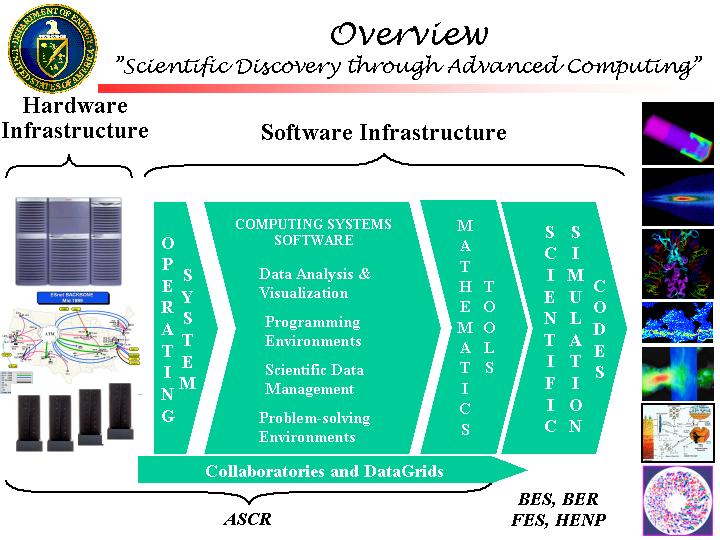| Read the SciDAC Program Plan |
| Advanced scientific computing will be a key
contributor to scientific research in the 21st Century.
Within the Office of Science (SC), scientific computing programs
and facilities are already essential to progress in many areas of research
critical to the nation. Major
scientific challenges exist in all SC research programs that can be
addressed through advances in scientific supercomputing – designing
materials atom-by- atom, revealing the functions of proteins,
understanding and controlling plasma turbulence, designing new particle
accelerators, and modeling global climate change, to name just a few. |
 |
The Opportunity:
Today's computers are 100 times faster than the
computers of a decade ago.
In the next five to ten years, the largest scientific computers
will be 1,000 times faster than today's. Using such computers, it
will be possible to dramatically extend our exploration of the
fundamental processes of nature as well as advance our ability to
predict the behavior of a broad range of complex natural and
engineered systems.
The Challenge: To exploit this opportunity, these
computing advances must be translated into corresponding increases in
the performance of the scientific codes used to model physical,
chemical, and biological systems.
This is a daunting problem.
Current advances in computing technology are being driven by
market forces in the commercial sector, not by scientific computing.Harnessing commercial computing technology for scientific
research poses problems never before encounteredin supercomputing, in magnitude as well as in kind.This problem will only be solved by increasing investments in
computer software – in research and development on
scientific modeling codes, as well as on the mathematical and
computing systems software that underlie these codes.
|
 | FY
2002 Investment Plan:In FY 2002 SC will continue the set of coordinated
investments, which were competitively selected in FY 2001, focused on
creating a Scientific Computing Software Infrastructure that
bridges the gap between advanced computing technologies and its
scientific research programs. The SC effort will:
|
|
To initiate this effort, the Office of Science issued six grant solicitation notices
with a combined value of $53 million. In response to these notices, more than 160 preproposals were received by mid-February 2001. The magnitude of the response shows the interest this
program has generated in the computational and scientific community.
|
The Benefits:
The Scientific Computing Software Infrastructure, along with the
upgrades to the hardware infrastructure, will enable laboratory and university
researchers supported by the Office of Science to solve the most challenging
scientific problems at a level of accuracy and detail never before achieved.
These developments will have significant benefit to all of the government
agencies which rely on high-performance scientific computing to achieve
their mission goals as well as to the U.S. high-performance computing
industry.
|


